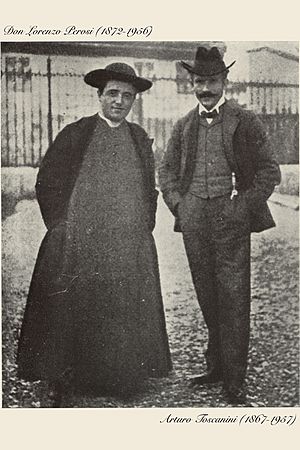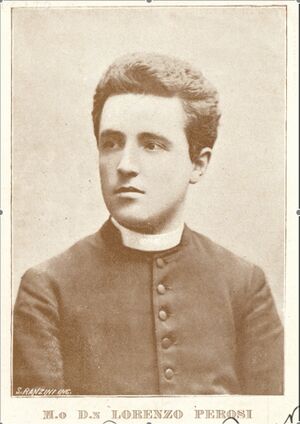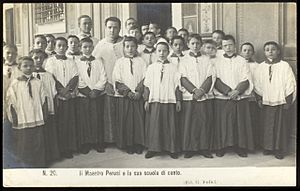Lorenzo Perosi facts for kids
Lorenzo Perosi (born December 21, 1872 – died October 12, 1956) was a famous Italian composer who wrote music for churches. He was special because he focused only on sacred music, unlike other composers of his time who wrote operas. When he was in his twenties, Perosi was already known around the world for his large musical works called oratorios. A famous writer, Romain Rolland, said it was hard to describe how popular Perosi was in Italy. His fame even reached America, with the New York Times calling him a "genius" in 1899. Perosi worked for five different Popes, including Pope Pius X, who helped him become very successful.
Contents
About Lorenzo Perosi
His Early Life and Learning
Lorenzo Perosi was born in Tortona, a town in Piedmont, Italy. He was one of twelve children, but only six lived past infancy. His family was very musical and religious. For almost 200 years, all of Lorenzo's ancestors were church musicians! His father, Giuseppe Perosi, was the choir director at Tortona Cathedral and a well-known church musician. Giuseppe taught Lorenzo and his two brothers, Carlo and Marziano, who also became important church figures.
Lorenzo later studied with a respected teacher, Michele Saladino, at the Milan Conservatory. Even when he wasn't officially enrolled, he kept learning from Saladino through letters.
In 1890, at 18, Perosi got his first job as an organist at the Abbey of Montecassino. He earned his diploma in 1892. Then, he spent a year studying with Franz Xaver Haberl in Regensburg, Germany. Haberl was a famous musician who edited the complete works of old masters like Palestrina. Haberl even offered Perosi a teaching job, but Perosi wanted to return to Italy. He felt it was his mission to create music for God in his home country. So, he became a teacher and director of sacred music in Imola from 1892 to 1894.
In 1894, Perosi went to Solesmes Abbey to learn about Gregorian chant. This ancient style of singing, along with the older polyphony he learned from Haberl, became the two main styles in all of Perosi's music.
Years in Venice
After Imola, Perosi got an even more important job. He became the director of music at San Marco's Basilica in Venice. This happened because of his close friendship with Cardinal Giuseppe Sarto, who was the Patriarch of Venice at the time. Cardinal Sarto loved music and was sad that Gregorian Chant had been missing from church services for about a hundred years. He wanted to bring back more traditional church music. So, Perosi found a great friend and supporter in Sarto.
Perosi's time in Venice, starting in 1894, led to a huge amount of music being written. He kept composing until he died, but this period (until 1907) produced some of his most important works.
In 1895, Perosi became a priest, ordained by his good friend Cardinal Sarto himself. Sarto and Perosi were also friends with Luigi Orione, who was born in Tortona in the same year as Perosi. These three friends inspired each other. Don Perosi was inspired by the future Pope Pius X to make his music holy. He would attend Mass every day and spend many hours in prayer.
Working at the Vatican

In 1898, Cardinal Sarto helped Perosi get a very important job in Rome. He became the Perpetual Director of the Sistine Choir at the Vatican. Five years later, Cardinal Sarto was elected Pope and became Pope Pius X. Soon after, Pope Pius X issued a special document called Tra le sollecitudini about sacred music. This document said that Gregorian Chant was the best kind of church music. It also said that women could not sing in church choirs, limited instruments to mostly the organ, and stopped people from using secular (non-religious) music in church.
Perosi stayed as the Perpetual Director until he died more than 50 years later. Even though he had some health challenges after 1907, he continued his work. By 1923, he was fully back to his duties, composing and even conducting many concerts in the last ten years of his life.
His Music
Lorenzo Perosi is thought to be the most productive composer of church music in the 20th century. Some experts believe he wrote between 3,000 and 4,000 pieces! Many of his works are still waiting to be published or even found. Everyone agrees that Perosi was the most important composer of the Cecilian Movement, which aimed to bring back traditional church music.
Even though his name might not be as well-known today, Perosi was a very important member of the Giovane Scuola (Young School) of composers. This group included famous opera composers like Puccini and Mascagni. Many famous musicians admired Perosi, including Toscanini and singers like Caruso. French composers like Debussy were also impressed by his music.
Unlike other composers of his time, Perosi was greatly inspired by older music from before the Classical period. He believed that artists should combine styles from all countries and times to create new art.
In his time, Perosi was most famous for his oratorios. These are large musical works for a choir, solo singers, and an orchestra, usually based on Latin religious texts. Perosi's oratorios were special because they mixed old styles like Renaissance polyphony and Gregorian chant with newer, dramatic melodies and orchestrations. His deep faith also shone through his music. Oratorios had not been very popular for a while, and Perosi's works brought them back into the spotlight, earning him international praise.
Besides his well-known oratorios and masses, Perosi also wrote some non-religious music. This included symphonic poems (orchestral pieces that tell a story), chamber music (music for small groups of instruments), and concertos. When he was young, he also wrote pieces for the organ.
It is said that Giacomo Puccini once commented, "There's more music in Perosi's head than in mine and Mascagni's put together."
See also
 In Spanish: Lorenzo Perosi para niños
In Spanish: Lorenzo Perosi para niños
- List of compositions by Lorenzo Perosi
List of Major Works
Oratorios
- La Passione di Cristo secondo S. Marco (1897)
- La Trasfigurazione di Cristo (1898)
- La Risurrezione di Lazzaro (1898)
- La Risurrezione di Cristo (1898)
- Il Natale del Redentore (1899)
- La Strage degli Innocenti (1900)
- Il Giudizio Universale (1904)
- Transitus Animae (1907)
Masses and Mottetti
- Missa In Honorem Ss. Gervasii et Protasii (1895)
- Missa In Honorem Beati Ambrosii (1895)
- Missa "Te Deum Laudamus" (1897)
- Missa Eucharistica (1897)
- Missa [Prima] Pontificalis (1897)
- Messa da Requiem (1897)
- Missa a Tre Voci Maschili (Missa Cerviana) (1898)
- Missa "Benedicamus Domino" (1899)
- Missa Secunda Pontificalis (1906)
- Melodie Sacre (eight volumes) (1897–1904)
Perosi's Successor
After Perosi passed away in 1956, his assistant, Domenico Bartolucci, became the new director of the Sistine Choir and Papal musician. Bartolucci held this important position until 1997.



